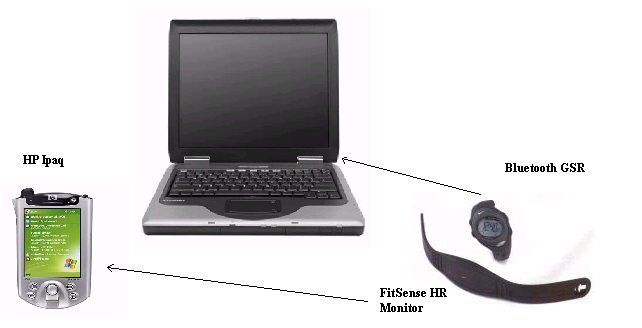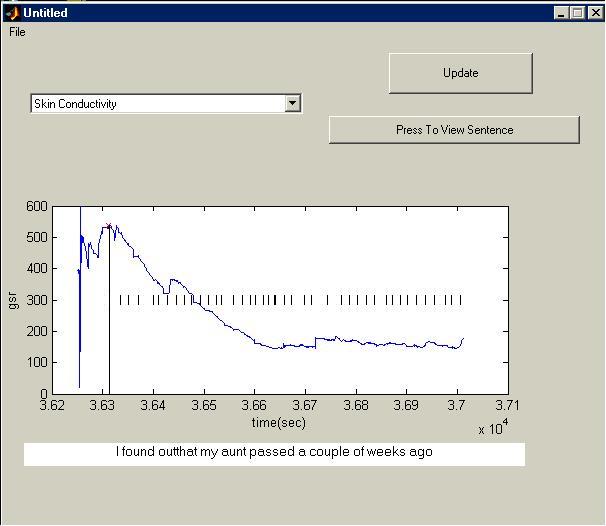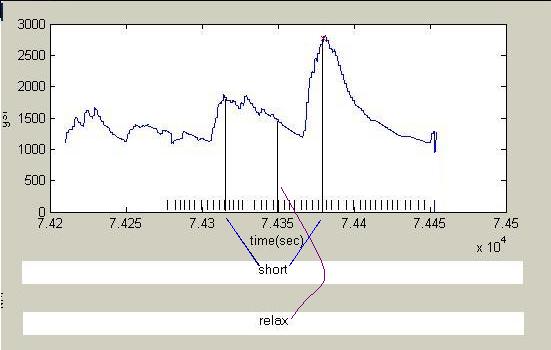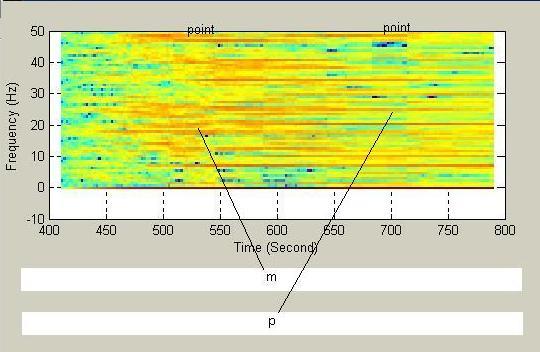
INNER-active Journal
MAS630- Final Project
Shaundra Bryant <bryant@media.mit.edu>
Abstract
Emotions have a large
impact on our physiology. Often we are unaware of how emotions aroused
during everyday events can affect our health. Expressive writing is a
technique used by psychologists that has been found to have profound effects on
health for those involved. However, the patient only receives information
from the doctor rather than actively being involved in his or her own process of
healing. The intent in designing this system is to enable users to gain a
better understanding of how emotions affect their bodies, expressive writing can improve
their emotional and physical health.
Background
James Pennebaker and
colleagues (1986) found that written emotional disclosure, writing about
extremely upsetting experiences in one's life, has profound effects on physical
and psychological health. The standard experimental design is to assign one
group the task of written emotional disclosure and the other group the task of
writing about superficial events such as the steps to brushing teeth. Each
group is instructed to write about the assigned topic for 15-20 minutes each day
for 3-5 days.
At the follow-up
interviews, participants show fewer doctor visits, improved immune functioning,
increased mood, and higher grade point averages. The conclusion drawn is
that writing about significant life events allows participants the opportunity
to find meaning and increased understanding of their emotional reactions to the
event. This can also result in reduced distress. This technique has been
shown to work in a variety of populations, from teenagers to grandparents.
An interesting question is why the act of writing emotions would be any better
than verbalizing them. Researchers have shown that emotional expression is
not enough to produce a cognitive reappraisal that is necessary for improvements
in mood and well being. This means that individuals must have the
opportunity to reappraise their cognitions related to the event and express
emotions related to the event (Murray et al., 1989). Another benefit of
writing is that it is a safe space to disclose things that may produce
discomfort if spoken about to others. In his book, Opening Up: the healing power
of expressing emotions, Pennebaker states:
"When disclosing deeply personal experiences, there are immediate changes
in brainwave patterns, skin conductance levels ... after confessions,
significant drops in blood pressure and heart rate, as well as improvements in
immune function, occur. In the weeks and months afterward, people's physical and
psychological health is improved." (pg. 56)
For
the purposes of the research, the skin conductivity, heart rate variability, and
heart stress entropy will be the focus. The galvanic skin response, or skin conductivity, is a
change in the electrical properties of the skin. The magnitude of the electrical resistance in the skin is
affected not only by one's general mood, but also by immediate emotional
reactions. Higher arousal (such as occurs with increased involvement) will
almost instantaneously (0.2 - 0.5 sec) cause a fall in skin resistance; reduced
arousal (such as occurs with withdrawal) will cause a rise in skin resistance.
Thus a rise or fall relates directly to reactive arousal, due to re-stimulation
of repressed mental conflict ("Tools," n.d.) Research from
HeartMath has shown that emotions are reflected in the heart rate variability.
The heart-brain interactions and the autonomic nervous system dynamics
are sensitive to changes in emotional states ("Learning," n.d.).
Although
there is no definitive, non-invasive method of directly measuring stress, heart
rate variability (HRV), which is calculated from the EKG, can be used as an
indicator. HRV is a form of sinus
arrhythmia that directly reflects bodily functions, and is typically measured
from the power spectrum of the inter-beat intervals (IBIs).
This usually involves windowing the ECG, detecting the beats and
computing the IBIs. From this, the
spectrogram of the time series of the IBI's is computed and divided into low-,
mid-, and high-frequency bands, which separates the relative influences of the
baroreflex as well as the parasympathetic and sympathetic nervous system activation
(McCraty, Atkinson et al. 1995). This
measure for stress uses a new algorithm (Qi, Minka et al. 2002), developed by
Yuan Qi at the MIT Media Lab, which computes spectral analysis for
non-stationary, unevenly sampled data by using a Kalman filter to jointly
estimate all spectral coefficients instantaneously.
After obtaining the spectral coefficients, the entropy of the result is
used as a measure for stress.
By
enabling people to view their own signals, they can see for themselves the
effect that their emotions have on their bodies. This makes them
active rather than passive receptors of this knowledge, which can also make them
active about expressing and learning about their own emotions.
The
Application
The system, shown in figure
X is programmed in Python2.3.3 and Matlab6.5.The system uses a Fitsense Heart
Rate Monitor to gather the heart rate data, along with a Bluetooth galvactivator,
created by Carson Reynolds to collect the galvanic skin response data. Once the
application is stopped, the data will be fed into the Matlab application. All
data is sent to the laptop via Bluetooth and stored in text files for access by
the application.

Figure 1: Entire InnerActive system
The
INNER-active Journal gives users a chance to view their heart rate variability,
stress level, and galvanic skin response. By
gaining an understanding of how emotions affect the body, users can begin to
take an active role in managing their emotional health. The application
begins with the user taking part in an expressive writing task. Once the
entry is finished, users can view the data collected through the interface shown
below. The drop down menu has the choice of 'Skin Conductivity',
'Instantaneous Heart Rate', and 'Heart Spectral Entropy'. Once the decision is
made, the "Update" button is pressed and the new graph is displayed.
If there are any interesting peaks in the skin conductivity or heart rate
graphs, the user can select the spot on the graph and then click the "Press
to View Sentence" button and see what sentence corresponds to the point on
the graph. The following graphic is from a session the designer set up to
demonstrate how the system functions.

Figure 2: Screenshot of Graph viewing portion of inner active Journal
Confirming Results
In order to get a better idea of whether the results obtained from the expressive writing session, two short experiments were conducted. In Experiment 1, shown in figure 3, quick short breaths, which is known to increase skin conductivity, was followed by relaxation. This was repeated twice. Next, running in place to increase the heart rate followed by listening to a favorite song were explored. As shown in figures 4 and 5, there is a noticeable difference when the subject is in motion, and at rest. There is also an interesting result that the heart rate increases when the subject's favorite song is played. Similar results were found in the stress measures.

Figure 3: Skin Conductivity Graph Experiment 1-
Short quick breaths followed by relaxation, repeated twice

Figure 4: Heart Rate Variability Graph Experiment 2 -
Running in place, followed by relaxation then listening to a favorite song.

Figure 5: Heart Stres Entropy graph for Experiment 2-
Running in place, followed by relaxation then listening to a favorite song.
There are a few things that should be considered, however, when using the system:
Thinking of an event before writing it may cause it to show up in body signals, so writing would not correspond exactly
Typing speed effects quality of data correlation
Heat from computer may affect GSR data
Future Work
Future work
will consist of making the components of the system and the interface better
integrated. Deleting some steps in
between data collection and viewing the interface will be helpful. Also, links to information about stress and the benefits of
expressive writing will be added.
References
McCraty,
R., Atkinson, M. Tiller, W.A., Rein, G., Watkins, A.D.(1995) The Effects
of Emotions on Short-Term Power Spectrun Analysis of Heart Rate Variability.
American Journal of Cardiology; 76(14): 1089-1093.
Murray, E. J., Lamnin, A., & Carver, C. (1989). Emotional expression in written essays and psychotherapy. Journal of Clinical and Social Psychology, 8, 414-429.
Pennebaker, J. W., & Beall, S. K. (1986). Confronting a traumatic event: Toward an understanding of inhibition and disease. Journal of Abnormal Psychology, 95, 274-281.
Pennebaker, J.W. (1997) Opening Up: the Healing Power of expressing emotions. New York: Guilford Press.
Learning Discoveries Psychological Services. (n.d.) Retrieved October 5, 2003 from http://home.iprimus.com.au/rboon/HeartRhythmsandHRV.htm
Tools for Transformation.(n.d.) Retrieved October 3, 2003 from http://www.trans4mind.com/psychotechnics/gsr.html
Special Thanks to...
Jesus
Carson
Win
Karen
Yaun
Amon